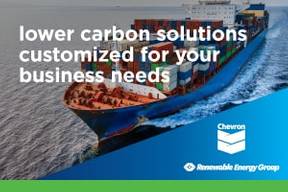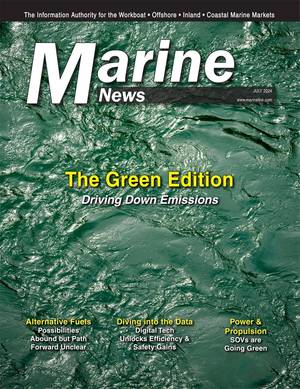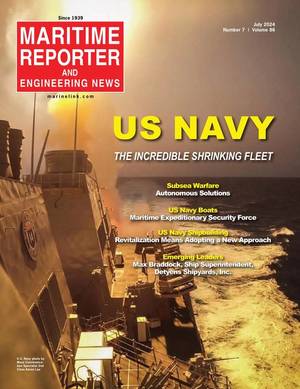New Codes And Regulatory Concerns Force Industry To Take Notice
In recent times, in light of environmental disasters caused by several infamous ship casualties, government and industry forces have begun to align, establishing codes and examining training standards, in an effort to protect the common ocean resource and the lives of seafarers. The new IMO SOLAS amendments have blazed a trail, serving to tighten and standardize international safety requirements, specifically by mandating enhanced inspections for bulkers and tankers; and the adoption of ship reporting systems for tracking vessel passages; emergency towing arrangements for tankers 20,000 dwt and above; special training requirements for tanker personnel under STCW; and port state control measures, which permit detailed ship inspections if vessel certificates are invalid or "when there are clear grounds for believing that the master or crew are not familiar with essential shipboard procedures relating to the safety of ships." The safety issue has occupied the spotlight lately, and is not only affecting changes in technology, shipboard practices and legislation, but has itself evolved, with a new emphasis on accident prevention replacing the traditional stress on post-incident response. The U.S. Coast Guard's (USCG) Office of Marine Safety, Security and Environmental Protection has introduced its Prevention Through People (PTP) program, which sets forth non-regulatory guidelines for decreasing risks associated with human error. And in an unprecedented move, the Washington state Office of Marine Safety has enacted its own ship risk regulations, sending a literal message to a profit-controlled industry to shape up its act in state waters, or ship out.
The Challenge Of Risk Management At a recent New York conference, Rear Admiral James C. Card, chief, U.S. Coast Guard (USCG) Office of Marine Safety, Security and Environmental Protection (OMS), reminded the industry that 80 percent of maritime accidents occur as a result of human error, and spoke about the grounding of Sea Empress as a "toe stubbing," saying that accidents usually occur after repeated mistakes. "A lot of tankers have been in and out of Milford Haven ...
There's no such thing as a risk-free environment. We have to be able to respond properly to these actions," said Radm. Card.
"It's not sufficient to write the regulations," he continued, and added that the USCG would lead the effort to put safety standards into practice, particularly through its Prevention Through People initiative. The program is intended to set up a means of preventing casualties throughout the maritime environment, including vessels and shoreside facilities, by looking for corrective actions in the human element of safety, and addressing the issue from an overall systems prospective.
The PTP strategy involves four basic elements: collaboration; risk management; human error detection; and improvement of investigations. Risk management specifically involves training USCG inspectors to recognize casualties before they occur, and includes provisions for collecting better data on near misses.
As explained by USCG Commander John Grenier, vessel operators can now file PTP forms in order to identify potential navigation disasters, an aspect of the program currently being exercised by barge fleet owners and riverboat owners on the inland waterways through USCG partnerships with the American Waterways Operators (AWO) and Passenger Vessel Association (PVA). "Owners will be able to come together and create a set of actions that will keep these (incidents) from ever occurring," said Commander Grenier.
Creating Appeal For An Incentive-Based Industry PTP is currently in its infancy stage, and USCG is seeking industry input, in order to work with companies to fashion implementation of program goals. One of the aspects of the program most appealing to industry is USCG's offer to create incentives for companies that have adopted quality management systems. As explained by Joseph J. Angelo, director of standards, OMS, at a recent BIMCO (The Baltic and International Maritime Council) gathering, the Streamline Inspection Program currently carried out in two districts in Louisiana and Seattle, is one program that operates on an incentive basis. Operators in these districts avoid "laborious inspections" by the USCG by implementing pre-approved quality programs onboard their ships. He suggested that this program could become more widespread under PTP if industry expressed a desire to work with the Coast Guard. Radm. Card has stressed that PTP will not be successful unless it is embraced by industry, and in another delivery at Shipping '96, he emphasized that the program is the Coast Guard's way of seeking a non-regulatory solution to the safety problem. He said that risk asssessment surveys should be deployed in every port, and added that the industry has to cultivate an understanding of the human element and its role in marine operations through continued research and understanding. He suggested that "near misses," be viewed in a positive light, namely as "good catches," and advocated sharing information within the maritime community. Radm. Card also expressed the need to streamline regulations, through the use of plain language, and said that business practices of the industry should be altered, specifically by improving the level of communications between industry and government.
Taking Substandard Operators To Task In 1991, the legislature of the state of Washington's interpretation of the public outcry following the Valdez disaster and other spills led to the drafting of the Washington Oil Spill Response and Prevention Act of 1991, and the establishment of the state's Office of Marine Safety (OSM). On April 1, 1996, this office was scheduled to adopt its own set of pro-active safety regulations intended to block the operation of substandard vessels in state waters.
These "ship risk" regulations set forth a vigorous boarding and inspection program for vessels predicted to pose substantial risks, and use "screening matrix" tools to assign vessel risk scores, a method similar to that used in USCG's port state control program.
According to Stan Norman, program director of the office's Policy and Planning division, the regulations are intended to send a message to the maritime industry, namely, that anyone operating below standards is not welcome. "We don't mind them gambling with their money, but we don't want them gambling with our environment," he said.
According to the new regulations, ships entering Washington waters that are perceived to pose substantial risks are evaluated in 11 categories, including age, flag, class society, vessel type and violation history. The higher the ship scores, the more likely state OSM officials will board the vessel. Although USCG has not expressed support for the program, it thus far has done nothing to put a stop to it, and according to Mr. Norman, "We contact the USCG at the field level every morning in an effort not to duplicate boardings." Mr. Norman further explained that the regulations are designed to fill gaps in safety requirements, adding, "Nothing is required by these regulations that is not mandated by federal or international law." For example, STCW standards are part of the "accepted industry standards" that Washington considers in its risk assessments, even though U.S. action on the matter has been stalled. The state office is also furthering the cause of safety by conducting studies on Bridge Resource Management.
Mr. Norman said that the new regulations, scheduled to go into effect on May 1, will not result in loss of business for the state's ports. "I think they'll cause some concern for the few substandard operators, (but) I think the predicted growth in trade will continue." He further stated, "I think the more pro-active industry elements will applaud what we're doing ... If other states would follow a similar approach, there would be no serious problems." Polarized Forces Plead Common Objective Ideally, safety at sea should involve a cooperative effort by industry and government agencies to provide a battery of standards that set forth training and shipboard requirements, and benefit really lies at the core of any effectively administered SMS. In this sense, the SMS achieves safety through quality management principles.
When considering how the Code will assist their respective operations, shipping companies must direct their focus beyond the implementation phase to truly appreciate how the active principles of the Code will channel efforts toward continual improvement. Positive changes within an organization are rarely the result of spontaneous luck. It is through the methodical and routine monitoring and objective self-assessment of various activities that continual improvement is effected.
Compared to the cost of an accident, implementing an SMS is relatively inexpensive.
By now this rationalization for implementing the Code seems a bit jaded. Since it isn't simply a matter of acceptance or approval of the code any longer, this slogan might best be replaced by one of the most direct expressions of the necessity for continual improvement in an increasingly competitive global market.
By maximizing their efforts to produce truly active Safety Management Systems within their organizations, shipping companies will not only be prepared to meet the requirements of the Code, but also appreciate positive growth individually and as a collective movement within the marine transportation business





